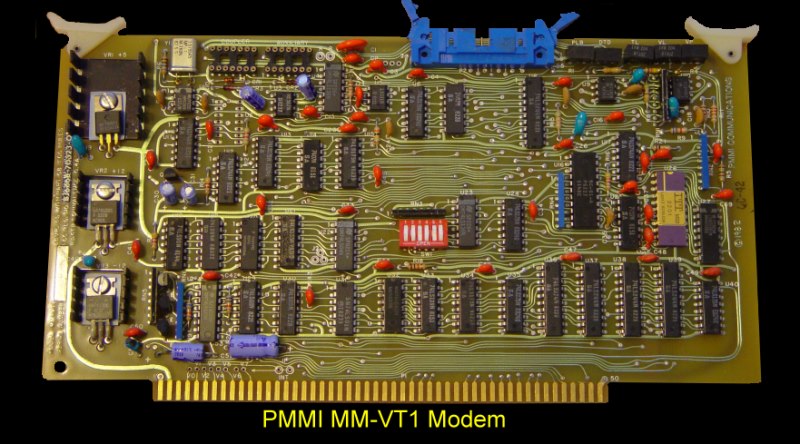
PMMI -- VT1 Modem
This was a specilized speech synthesis board to allow long distance dial
tome control of a computer over the phone lines. Acknowledgement of received
commands came aback as voice sounds.

The MM-VT1 was an IEEE 696/S-100 compatible
telecommunications device which allowed a remote user to interface
effectively with a microcomputer over the telephone line without the need of
any kind of terminal device. All that was required was a Touch-Tone
telephone so that the user can use the pad to key in data or instructions.
The MM-VT1 could prompt the user and acknowledge receipt of data via the
onboard speech synthesizer. The PMMI MM-VT1, was a direct connect device, it
interfaced directly to the phone line. It was approved by the FCC under Part
68 of the FCC rules. The MM-VT1 was also been verified under Part 15 of the
FCC rules as a Class A computing device.
The MM-VT1 could bring new and powerful capabilities to your computer
system. Now you could call your computer and receive inventory, alarm or
status information from any Touch-Tone phone. The MM-VT1 was suited
especially well for remote computer locations where automatic calling and
reporting capability was a must. Remote control of equipment was easily
implemented with the onboard parallel port. The board generated voice could
give you positive feedback on system or equipment performance and keep you
informed on the progress of commands you've previously entered on the
Touch-Tone pad.
The onboard speech synthesizer used was a phoneme-type with unlimited
vocabulary. With PMMI's software, you could easily create your own
vocabulary to suit your own special needs. Inflection of speech was adjusted
through software to one of four levels for each phoneme. The starting
inflection was continuously adjustable from a growl to a 'Mickey Mouse'
sound using the adjustment marked "VP" on the board.
The Touch-Tone encoder and decoder generated and receive all 16 tones
including A, B, C and D, which are not on the normal Touch-Tone phone, but
are part of the standard DTMF (dual tone multifrequency) frequencies. Data
reliability and integrity was extremely high using the DTMF technique. The
board also had ample sensitivity to detect tones in most every application.
The MM-VT1 board came optionally without the speech synthesizer and parallel
port for applications which only required Touch-Tone sending and receiving.
The board required 4 IO ports which could be on any 4 byte boundary.
The manual for this board can be obtained
here.
This page was last modified
on
01/08/2011


